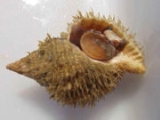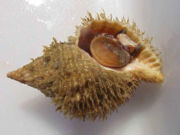
Fusitriton oregonensis
Encyclopedia
The Oregon hairy triton, Fusitriton oregonensis, is a species
of large predatory sea snail
, a marine
gastropod mollusk in the family Ranellidae
, the tritons.
The snail was given its specific name oregonensis (meaning "of Oregon") to honor the Oregon Territory
by conchologist John Howard Redfield in 1846.
The Oregon hairy triton was declared the state seashell of Oregon
in 1989 by the 65th Legislative Assembly
.
. The shells are found from Alaska
to California
, as well as in northern Japan
. The shells often wash up on the coast during high tide
s.
The shell is light brown in color and is covered with gray-brown bristly periostracum
, hence the name "hairy." The shell is an elongate cone with six whorls
(or turns) around a central axis.
, ascidians
("sea squirts"), and more rarely, sea urchin
s.
The species also holds the record for longest larval development period of any marine invertebrate, able to delay metamorphosis for over 4 years until presented with appropriate habitat. Under laboratory conditions, the larvae showed no signs of senescence
at that point. According to some authorities, four years is long enough to drift completely across the Pacific Ocean
.
Species
In biology, a species is one of the basic units of biological classification and a taxonomic rank. A species is often defined as a group of organisms capable of interbreeding and producing fertile offspring. While in many cases this definition is adequate, more precise or differing measures are...
of large predatory sea snail
Snail
Snail is a common name applied to most of the members of the molluscan class Gastropoda that have coiled shells in the adult stage. When the word is used in its most general sense, it includes sea snails, land snails and freshwater snails. The word snail without any qualifier is however more often...
, a marine
Marine (ocean)
Marine is an umbrella term. As an adjective it is usually applicable to things relating to the sea or ocean, such as marine biology, marine ecology and marine geology...
gastropod mollusk in the family Ranellidae
Ranellidae
Ranellidae, common name the triton shells or tritons, is a taxonomic family of small to very large predatory sea snails, marine gastropod mollusks in the clade Littorinimorpha.-Subfamilies:...
, the tritons.
The snail was given its specific name oregonensis (meaning "of Oregon") to honor the Oregon Territory
Oregon Territory
The Territory of Oregon was an organized incorporated territory of the United States that existed from August 14, 1848, until February 14, 1859, when the southwestern portion of the territory was admitted to the Union as the State of Oregon. Originally claimed by several countries , the region was...
by conchologist John Howard Redfield in 1846.
The Oregon hairy triton was declared the state seashell of Oregon
Oregon
Oregon is a state in the Pacific Northwest region of the United States. It is located on the Pacific coast, with Washington to the north, California to the south, Nevada on the southeast and Idaho to the east. The Columbia and Snake rivers delineate much of Oregon's northern and eastern...
in 1989 by the 65th Legislative Assembly
Oregon Legislative Assembly
The Oregon Legislative Assembly is the state legislature for the U.S. state of Oregon. The Legislative Assembly is bicameral, consisting of an upper and lower house: the Senate, whose 30 members are elected to serve four-year terms; and the House of Representatives, with 60 members elected to...
.
Distribution
The Oregon hairy triton is native to the northwestern coast of North AmericaNorth America
North America is a continent wholly within the Northern Hemisphere and almost wholly within the Western Hemisphere. It is also considered a northern subcontinent of the Americas...
. The shells are found from Alaska
Alaska
Alaska is the largest state in the United States by area. It is situated in the northwest extremity of the North American continent, with Canada to the east, the Arctic Ocean to the north, and the Pacific Ocean to the west and south, with Russia further west across the Bering Strait...
to California
California
California is a state located on the West Coast of the United States. It is by far the most populous U.S. state, and the third-largest by land area...
, as well as in northern Japan
Japan
Japan is an island nation in East Asia. Located in the Pacific Ocean, it lies to the east of the Sea of Japan, China, North Korea, South Korea and Russia, stretching from the Sea of Okhotsk in the north to the East China Sea and Taiwan in the south...
. The shells often wash up on the coast during high tide
High Tide
High Tide was a band formed in 1969 by Tony Hill , Simon House , Peter Pavli and Roger Hadden .-History:...
s.
Shell description
The shells grow from three to five inches long.The shell is light brown in color and is covered with gray-brown bristly periostracum
Periostracum
The periostracum is a thin organic coating or "skin" which is the outermost layer of the shell of many shelled animals, including mollusks and brachiopods. Among mollusks it is primarily seen in snails and clams, i.e. in bivalves and gastropods, but it is also found in cephalopods such as the...
, hence the name "hairy." The shell is an elongate cone with six whorls
Whorl (mollusc)
A whorl is a single, complete 360° revolution or turn in the spiral growth of a mollusc shell. A spiral configuration of the shell is found in of numerous gastropods, but it is also found in shelled cephalopods including Nautilus, Spirula and the large extinct subclass of cephalopods known as the...
(or turns) around a central axis.
 |
Life habits
Little is known of the snail's feeding habits, but they are believed to feed on other mollusksMollusca
The Mollusca , common name molluscs or mollusksSpelled mollusks in the USA, see reasons given in Rosenberg's ; for the spelling mollusc see the reasons given by , is a large phylum of invertebrate animals. There are around 85,000 recognized extant species of molluscs. Mollusca is the largest...
, ascidians
Ascidiacea
Ascidiacea is a class in the Tunicata subphylum of sac-like marine invertebrate filter feeders. Ascidians are characterized by a tough outer "tunic" made of the polysaccharide tunicin, as compared to other tunicates which are less rigid.Ascidians are found all over the world, usually in shallow...
("sea squirts"), and more rarely, sea urchin
Sea urchin
Sea urchins or urchins are small, spiny, globular animals which, with their close kin, such as sand dollars, constitute the class Echinoidea of the echinoderm phylum. They inhabit all oceans. Their shell, or "test", is round and spiny, typically from across. Common colors include black and dull...
s.
The species also holds the record for longest larval development period of any marine invertebrate, able to delay metamorphosis for over 4 years until presented with appropriate habitat. Under laboratory conditions, the larvae showed no signs of senescence
Senescence
Senescence or biological aging is the change in the biology of an organism as it ages after its maturity. Such changes range from those affecting its cells and their function to those affecting the whole organism...
at that point. According to some authorities, four years is long enough to drift completely across the Pacific Ocean
Pacific Ocean
The Pacific Ocean is the largest of the Earth's oceanic divisions. It extends from the Arctic in the north to the Southern Ocean in the south, bounded by Asia and Australia in the west, and the Americas in the east.At 165.2 million square kilometres in area, this largest division of the World...
.

